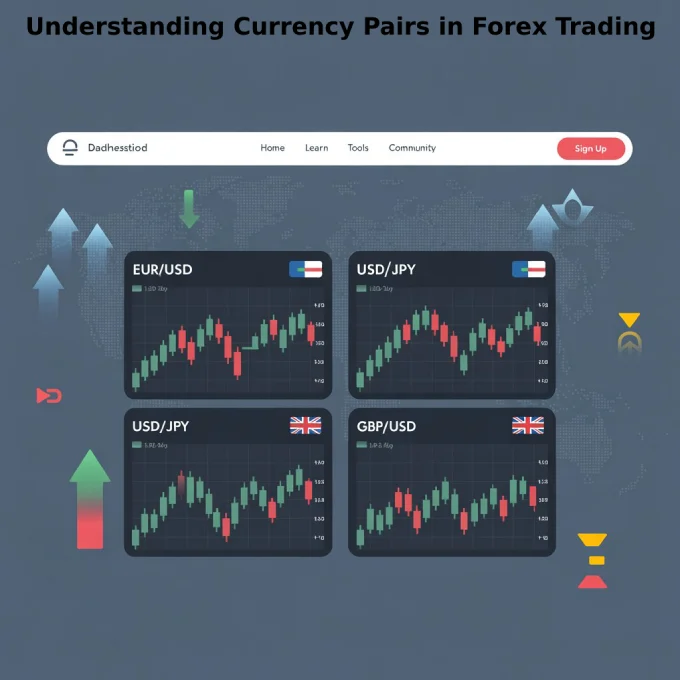In forex trading, you have to trade two different currencies paired together. A strong understanding of currency pairs is necessary for making good and profitable choices in forex. Here, we’ll look at what currency pairs are, how they function, their different types, how to select ones to trade and the right times to trade them.
What Are the Forex Currency Pairs?
When trading in forex, a currency pair shows the exchange rate of two currencies. The base currency is the first one and the second is the quote currency. For the currency pair EUR/USD, the euro is the base currency and the quote currency is the U.S. dollar.
It expresses the number of quote units that are required to get one unit of the base currency. If EUR/USD is 1.10, then you get 1.10 U.S. dollars when you convert 1 euro.
Currency pairs are only transacted in pairs. You make a purchase or a sale based on which way you think the market is headed.
How Do Currency Pairs Work in Trading?
When trading forex, you are buying one currency and selling another at the same time. Here’s how it works:
- Buy (Long) Position: You buy the base currency and sell the quote currency.
- Sell (Short) Position: You sell the base currency and buy the quote currency.
Traders look to earn money by making a prediction about the direction of the base currency versus the quote currency. If you believe the euro will cost more U.S. dollars, you would purchase EUR/USD.
Prices change as a result of interest rates, important economic facts, political news and overall market mood. Traders rely on technical and fundamental analysis to help them decide what to do.
Learn more about trading basics in our Complete Guide to Forex Trading.
How Currency Pair Quotes Work
Each currency pair quote has two prices:
- Bid Price: The price at which the market is willing to buy the base currency.
- Ask Price: The price at which the market is willing to sell the base currency.
The difference between these two is called the spread. The tighter the spread, the lower the cost of trading.
Understanding Pip and Lot Size in Currency Pairs
What Is a Pip?
A pip (percentage in point) is the smallest price movement a currency pair can make. For most pairs, one pip equals 0.0001.
What Is a Lot?
A lot is the standard unit of trade. There are three main types:
- Standard lot: 100,000 units
- Mini lot: 10,000 units
- Micro lot: 1,000 units
Understanding pip and lot size is essential to manage risk and calculate profits/losses.
Major vs Minor vs Exotic Currency Pairs
Currency pairs fall into three main types:
Major Currency Pairs
These pairs include the most traded currencies in the world and always feature the U.S. dollar. They offer high liquidity, low spreads, and relatively low volatility. Examples:
- EUR/USD (Euro/US Dollar)
- GBP/USD (British Pound/US Dollar)
- USD/JPY (US Dollar/Japanese Yen)
- USD/CHF (US Dollar/Swiss Franc)
- USD/CAD (US Dollar/Canadian Dollar)
- AUD/USD (Australian Dollar/US Dollar)
- NZD/USD (New Zealand Dollar/US Dollar)
Minor Currency Pairs
These pairs do not include the U.S. dollar but involve other major currencies. They are less liquid and have slightly higher spreads. Examples:
- EUR/GBP (Euro/British Pound)
- EUR/AUD (Euro/Australian Dollar)
- GBP/JPY (British Pound/Japanese Yen)
- CHF/JPY (Swiss Franc/Japanese Yen)
Exotic Currency Pairs
These combine a major currency with a currency from an emerging or smaller economy. They are less liquid and have wider spreads. Examples:
- USD/TRY (US Dollar/Turkish Lira)
- EUR/THB (Euro/Thai Baht)
- USD/ZAR (US Dollar/South African Rand)
- USD/SEK (US Dollar/Swedish Krona)
Exotic pairs have higher volatility and spreads, so they are riskier. They are best for experienced traders who understand these markets.
How to Choose the Right Currency Pair
Choosing the right currency pair depends on your trading goals, experience, and strategy.
1. Volatility
More volatile pairs move faster, offering greater profit opportunities but also higher risk. If you’re new, stick with less volatile pairs like EUR/USD or USD/CHF.
2. Trading Time
Some pairs are more active during specific trading sessions. For example:
- Asian session (Tokyo): JPY, AUD, NZD pairs
- European session (London): EUR, GBP, CHF pairs
- American session (New York): USD, CAD pairs
3. Economic News
Pairs affected by major news events, such as central bank meetings or employment reports, can be more volatile. Stay updated on economic calendars.
4. Spread Costs
Major pairs have lower spreads, which makes them cheaper to trade. Exotic pairs have wider spreads, increasing trading costs.
5. Your Trading Style
Scalpers prefer low-spread pairs like EUR/USD. Swing traders may go for more volatile pairs like GBP/JPY. Day traders often stick with majors for reliability.
Want to understand the bigger picture? Check out our article on How Forex Trading Work.
Most Traded Currency Pairs in the World
Here are the most commonly traded currency pairs:
EUR/USD (Euro/US Dollar)
Most liquid and widely traded pair. Offers tight spreads and high trading volume.
USD/JPY (US Dollar/Japanese Yen)
Popular due to Japan’s large economy and the yen’s role in global trade.
GBP/USD (British Pound/US Dollar)
Known for larger movements and volatility. Great for experienced traders.
USD/CHF (US Dollar/Swiss Franc)
Seen as a “safe haven” pair. Traders use it during economic uncertainty.
AUD/USD (Australian Dollar/US Dollar)
Closely linked to commodity prices and the Chinese economy.
USD/CAD (US Dollar/Canadian Dollar)
Influenced by oil prices and U.S. and Canadian economic data.
These pairs account for over 75% of all forex trading volume globally.
Best Time to Trade Currency Pairs
The forex market is open 24 hours a day, five days a week. But the best times to trade are when market activity is highest:
Best Trading Sessions
- London & New York Overlap (8 AM – 12 PM EST): Most liquid and volatile time
- London Session (3 AM – 12 PM EST): High volume, good for EUR, GBP
- New York Session (8 AM – 5 PM EST): Active session, ideal for USD pairs
Avoid Low Volume Times
Avoid trading between 5 PM and 7 PM EST, when major markets are closed and volatility drops.
Consider News Releases
Plan your trades around economic reports like Non-Farm Payrolls (NFP), interest rate decisions, and inflation data. These can cause sharp moves.
Risk Management for Currency Pair Trading
Trading without a plan is like sailing without a compass. Risk management is key.
1. Set a Stop Loss
This limits your loss if the trade goes the wrong way. Always use it.
2. Define Risk-Reward Ratio
A good rule is 1:2. Risk $1 to potentially make $2.
3. Use Position Sizing
Don’t risk more than 1-2% of your account on a single trade.
4. Track and Review Trades
Keep a journal to learn from your wins and losses.
FAQs About Currency Pairs in Forex
What are the safest currency pairs to trade?
Major pairs like EUR/USD, USD/JPY, and USD/CHF are considered safe due to high liquidity and low spreads.
Can I trade exotic pairs as a beginner?
It’s possible but not recommended. Exotic pairs are riskier, less liquid, and costlier to trade.
Do currency pairs behave differently?
Yes. Each pair reacts to different economic conditions and trading sessions. Understanding their patterns is key.
How many currency pairs should I trade?
Start with one or two pairs and get familiar with their behavior before adding more.
Do trading hours matter?
Yes. Trading during active sessions gives better spreads, faster execution, and more movement.
Are some currency pairs better for beginners?
Yes. Stick to major pairs like EUR/USD and USD/JPY. They are easier to follow, cheaper to trade, and have tons of educational resources.
Final Words
You need to know about currency pairs in forex trading in order to perform well. From knowing the difference between major and minor pairs to picking the right few minutes to trade, it is all important.
Paying attention to suitable currency pairs, working during peak hours and following up-to-date news on the world economy helps you increase your success. New traders should begin with the popular major pairs, do not use exotic ones right away and practice on practice accounts.
For a full overview of forex trading, read our Complete Guide to Forex Trading and How Forex Trading Work.




